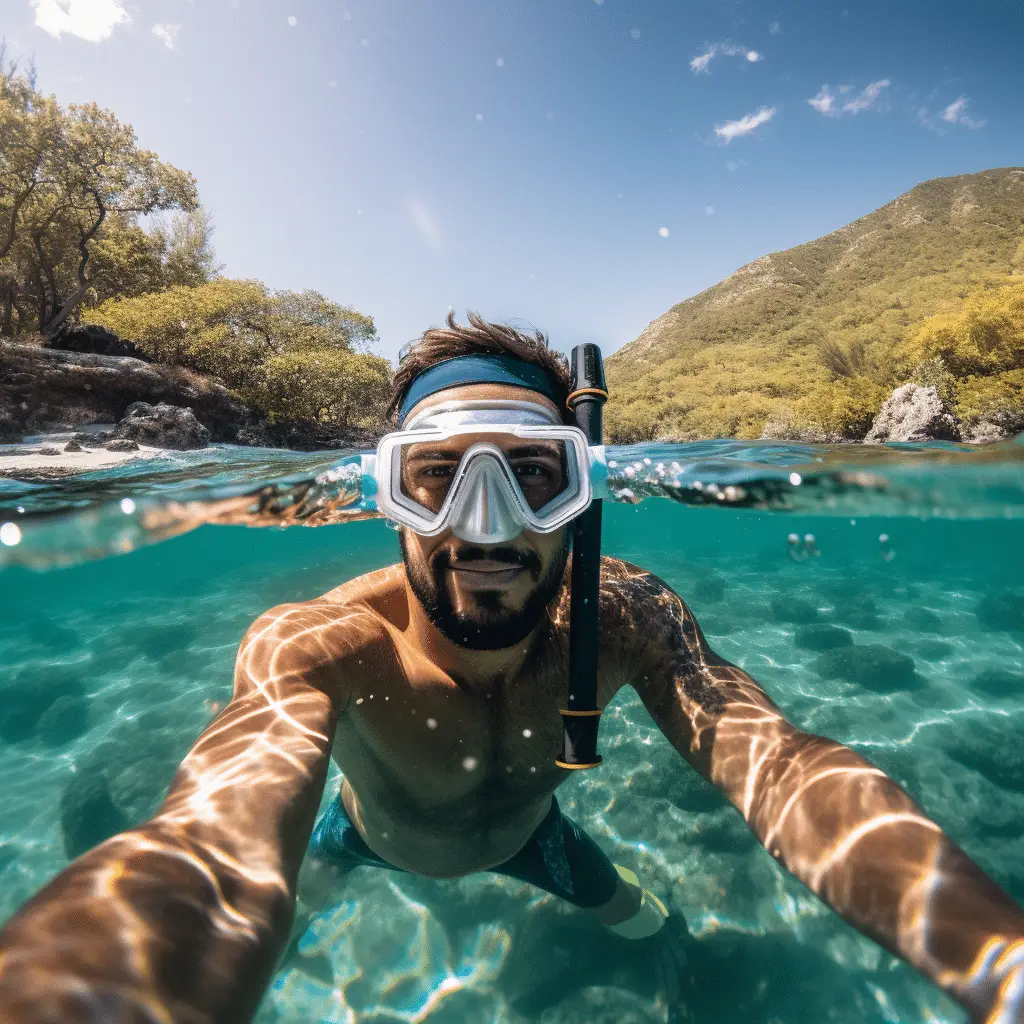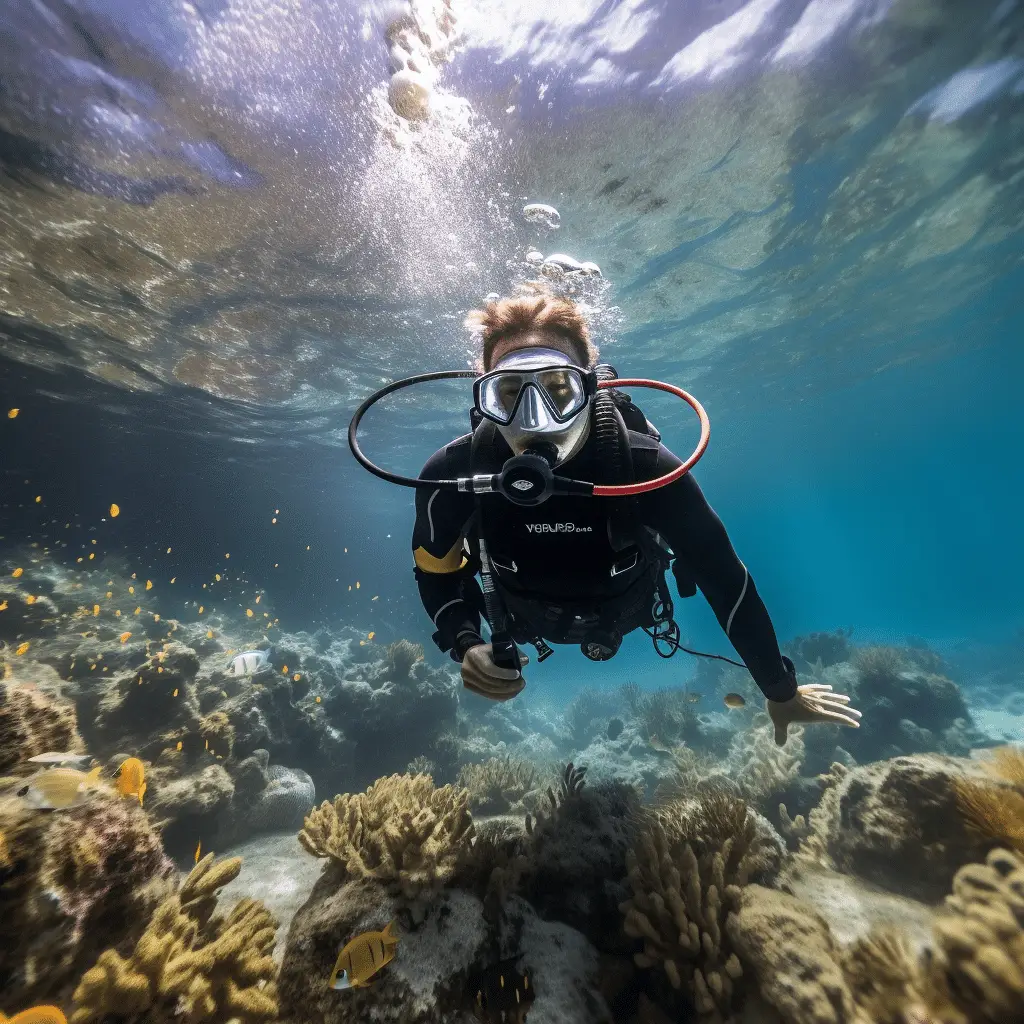Snorkeling is an exciting underwater recreational activity that involves swimming on the surface of relatively shallow waters with the help of a breathing tube known as a snorkel. People who enjoy snorkeling do so to observe marine life and a natural underwater environment.
Many people don’t think of snorkeling as an activity that needs a lot of equipment, especially when compared to scuba diving. However, there are many parts to a snorkeling outfit, and each has a significant purpose. Some parts are non-essential, but they are recommended. Here’s an in-depth look at all the parts of a snorkeling outfit.

Snorkel
Because human beings aren’t naturally able to breathe underwater, a crucial part of snorkeling is the use of a device to help pull surface air into the water for breathing. This device is known as a snorkel. Some models are attached to a diving mask, while others are simply the snorkel (breathing device).
At a glance, it seems to be nothing but a tube inserted into the mouth that is rigid enough to protrude out of the water while the swimmer is exploring underwater (face-down). There is a little more to it, making a snorkel than that and using a snorkel requires some training (not extensive).
Tube Diameter
The air we breathe out is not the same as that which we breathe in. Dead space is a term that pulmonologists (doctors who study breathing) use to describe the portion of inhaled air that is not involved in the respiratory process. Snorkeling outfit, Because snorkeling involves breathing into and out of the same tube, the air inside the snorkel can be considered part of dead space.
The problem with inhaling from dead space is that with each breath, the percentage of carbon dioxide increases, and snorkelers risk getting a condition called hypercapnia. That is why snorkels need to be narrow tubes to reduce the amount of dead space. However, if you’ve ever tried breathing through a straw (very narrow), you understand how difficult it is to breathe through a narrow tube. Snorkels balance between the two to give relatively comfortable breathing without the risk of hypercapnia.
Mouthpiece
Several mouthpiece models are used in snorkels, and everyone has their preferences with regards to which mouthpiece is more comfortable. It is usually made of soft rubber or rubber-like material such as silicon or plastic (PVC).
The mouthpiece of a snorkel helps secure it in place and usually has two lugs that can be held between the teeth. However, biting down excessively can be painful and tiring.
These are the two main types of snorkel :
Maskless (Plain) Snorkel
This is the basic snorkel that only includes a tube. Using goggles or a scuba mask with this type of snorkel is required for clear vision underwater. The material used may be plastic, metal, or rubber, but it must be relatively hard.
Some models have a valve in the barrel to avoid water entering into the tube if the swimmer dives deeper and submerges the snorkel entirely into water. Snorkel keepers are parts that are sold separately to help fasten the snorkel to the side of the head.
Full Face Snorkel
This type of snorkel covers the entire face area, with a snorkel tube attached above. The snorkel has a valve to avoid flooding the inside of the maskhttps://divingpicks.com/top-10-best-snorkel-masks/, has a separate system for inhalation and exhalation.
Full-face snorkel masks are inherently easier to use because they do not require the use of a mouthpiece. Snorkeling outfit, This makes a remarkable difference for people who find the mouthpiece difficult to get used to, and also because it allows for both nasal and oral inhalation. Also, because the intake and exhaled air go through separate channels, there is no risk of increasing dead space.
High-end full-face snorkels have a valve to drain any water inside the mask to ensure there is no risk of drowning. Nonetheless, these types of snorkels need to have a tight seal around the face to work properly.
Diving Mask
For those that do not want to use a full-face snorkel, a diving mask is an essential part of snorkeling gear. This is the same type of mask that scuba divers use.
The joy of snorkeling lies in observing and interacting with the underwater environment and thus requires some form of goggles or diving mask to enable snorkelers to see.
Diving masks use the same type of lenses that swimming goggles use, adjusting the refraction of light underwater to the way humans are used to observing the world. The lens is secured to the face using a rubber skirt that creates a seal around the eyes and nose, and a head strap is used to adjust the tightness accordingly.
When adjusting the head strap, it is important not to go too tight. Very little pressure is required for creating an effective seal.
Weight Belt
In most bodies of water, humans are somewhat buoyant. That is, we float in water. This can be a problem for inexperienced swimmers when trying to stay underwater for long periods, such as snorkeling. To counteract this buoyancy while snorkeling, many choose to use a weighted belt. This allows for more control of movement so as to observe marine life easily.
Most belts come with a quick-release buckle that allows a snorkeler to dump the weight in the event of an emergency. Otherwise, it might pose the risk of drowning.
Older weight belt models were abrasive, but newer models are often coated in plastic and marked as non-abrasive. This is important to avoid damaging a wetsuit by using a weight belt.
Fins
Also known as flippers, fins are footwear used to help control movement while swimming better. They allow for more efficient swimming by creating more thrust with each kick. They are essential for scuba diving and snorkeling alike.
Snorkeling requires swimmers to float in one position for a relatively long period and maneuvering corals and other underwater rocks. Fins help control movement as well as keep waves from pushing the swimmer around.
Longer fins are more helpful for scuba diving and swimming for longer distances. For recreational snorkeling, it is recommended to use flexible fins that are also lightweight. They should also be short (under 25cm) because long fins are only useful for swimming long distances. Shorter fins are also easier to control, and they won’t have you bumping into corals and disturbing your surroundings very much.
Clothing
It is possible to go snorkeling with normal swimming attire. However, to protect against exposure to the elements and other hazards, special clothing is recommended. The following are the common types of clothing worn by people when participating in recreational snorkeling.
Rash Guard
These are swim-shirts that are worn for several recreational water activities, including snorkeling. Snorkeling outfit, They provide protection against rashes and prolonged sun exposure (which might cause sunburns).
It is especially important when snorkeling because most snorkeling is done in sunny weather and exposes the back to sunlight for longer periods. Rash guards do not offer any thermal insulation, so they are not suitable for use in cooler waters.
Diving Suit
A diving suit (aka dive skin) is a type of full-body swimwear that was first developed with the aim of protecting divers from stinging jellyfish. Nowadays, they are used by scuba divers and snorkelers alike, providing exposure protection (from the sun) as well as protection from stings. They also help avoid minor abrasions from rubbing against rocks underwater.
Some people wear a diving suit under a wetsuit if they feel the neoprene material of wetsuits is uncomfortable. Additionally, it makes changing into and out of a wetsuit easier.
Wetsuit
These are the same wetsuits that scuba divers wear, and they provide exposure protection from the sun and from temperature drops. They are also protective against abrasions and stings from marine life.
The material used for wetsuits is neoprene, which is highly hydrophobic. It creates an insulative layer on the skin to keep swimmers comfortable in lower temperatures and avoid the risk of hypothermia.
The insulation provided is from small bubbles trapped in the mesh of the material (much like bubble wrap). Wetsuits are available in varying thicknesses, from 1mm to 7mm, depending on their intended use. They also come in a wide range of styles, some offering complete coverage (head to toes), whereas others may only cover the torso and part of the limbs.

Snorkeling Vest
An optional garment that can be added to a snorkeling outfit is a type of life-vest, called a snorkeling vest. It is a type of buoyancy aid that can be inflated in case of emergencies. They are usually equipped with oral inflation or carbon dioxide discs for auto-inflation. Very few snorkelers use snorkeling vests, but they are usually used by tourists that are first-time snorkelers.
A snorkeling outfit is not as complicated or technological as a scuba diving suit, but there are many essential components to it. A proper understanding of their uses and the importance of each part is helpful when preparing for a snorkeling session.
Now that you know some of the essentials types of equipment of snorkeling you may want to learn how to maintain them. Rule number one for maintaining them is to clean your equipment after you finish diving. Have you ever thought you can clean them with vinegar?! Check this article and learn How to clean your scuba gear with vinegar?
